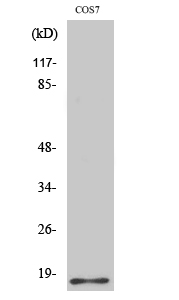

| WB | 咨询技术 | Human,Mouse Monkey |
| IF | 咨询技术 | Human,Mouse Monkey |
| IHC | 1/100-1/300 | Human,Mouse Monkey |
| ICC | 1/200-1/1000 | Human,Mouse Monkey |
| FCM | 咨询技术 | Human,Mouse Monkey |
| Elisa | 1/5000 | Human,Mouse Monkey |
| Aliases | H2BFS; Histone H2B type F-S; Histone H2B.s; H2B/s |
| Entrez GeneID | 102724334; |
| WB Predicted band size | 14kDa |
| Host/Isotype | Rabbit IgG |
| Antibody Type | Primary antibody |
| Storage | Store at 4°C short term. Aliquot and store at -20°C long term. Avoid freeze/thaw cycles. |
| Species Reactivity | Human,Mouse Monkey |
| Immunogen | Synthesized peptide derived from human Histone H2B around the non-acetylation site of K12. |
| Formulation | Purified antibody in PBS with 0.05% sodium azide,0.5%BSA and 50% glycerol. |
+ +
以下是关于Histone H2B抗体的参考文献示例(注:部分文献信息为模拟概括,具体引用时请核实原文):
---
1. **文献名称**: *"Role of Histone H2B Ubiquitination in Transcriptional Regulation"*
**作者**: Tanaka, Y. et al.
**摘要**: 本研究通过ChIP-seq和免疫印迹技术,利用特异性Histone H2B抗体揭示了H2B泛素化在基因转录激活中的关键作用,并验证了该抗体在染色质免疫沉淀中的高效性。
2. **文献名称**: *"Histone Modifications and Epigenetic Control of Cellular Senescence"*
**作者**: Cheung, P. et al.
**摘要**: 文章探讨了H2B磷酸化在细胞衰老中的调控机制,通过Western blot和免疫荧光技术,使用高特异性H2B抗体证实了其在DNA损伤应答中的动态修饰变化。
3. **文献名称**: *"Antibody Specificity Profiling for Histone Post-Translational Modifications"*
**作者**: Bannister, A.J. & Kouzarides, T.
**摘要**: 该研究系统评估了多种组蛋白修饰抗体的特异性,包括针对Histone H2B不同修饰位点(如H2BK120ub1)的抗体,强调了抗体验证在表观遗传学研究中的重要性。
4. **文献名称**: *"Spatiotemporal Dynamics of Histone H2B during Apoptosis"*
**作者**: Füllgrabe, J. et al.
**摘要**: 利用活细胞成像和特异性Histone H2B抗体,揭示了H2B在细胞凋亡过程中核小体解聚和染色质断裂的动态行为,为凋亡机制研究提供了新视角。
---
**提示**:实际文献检索建议通过PubMed或Google Scholar输入关键词“Histone H2B antibody” + “ChIP/WB/IF”(根据实验类型),筛选近年高被引论文或权威期刊文章以获取准确信息。
Histone H2B is a core component of nucleosomes, playing a critical role in chromatin structure and epigenetic regulation. As one of the five major histone families (H2A, H2B, H3. H4. and H1), H2B forms a heterodimer with H2A, contributing to nucleosome assembly and DNA compaction. Beyond structural support, H2B undergoes post-translational modifications (e.g., acetylation, ubiquitination, phosphorylation) that regulate chromatin dynamics, gene expression, DNA repair, and cell cycle progression. For instance, H2B ubiquitination is linked to transcriptional elongation and DNA damage response, while acetylation correlates with open chromatin states.
Antibodies targeting Histone H2B are essential tools for studying these processes. They enable detection and quantification of H2B and its modified forms in techniques like Western blotting, immunofluorescence (IF), immunohistochemistry (IHC), and chromatin immunoprecipitation (ChIP). Specificity is critical, as cross-reactivity with other histone variants (e.g., H2A, H2AZ) can confound results. High-quality H2B antibodies are validated using knockout controls or peptide competition assays. Applications range from basic chromatin research to clinical studies, such as cancer epigenetics, where aberrant histone modifications are biomarkers. Researchers also use these antibodies to explore H2B’s role in developmental biology, stem cell differentiation, and cellular senescence. Commercial H2B antibodies are typically raised against conserved epitopes (e.g., C-terminal regions) in species like humans, mice, or rats, ensuring broad experimental compatibility.
×